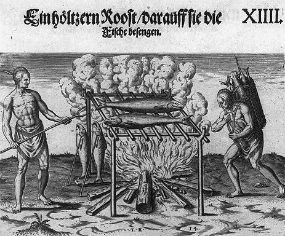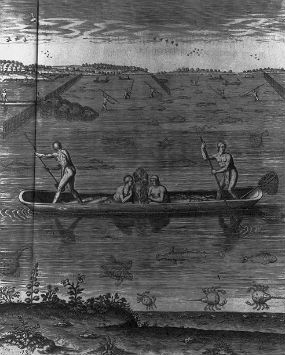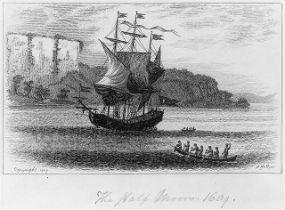Pre-Contact to Colonization
Library of Congress Today, Liberty Island is home to the Statue of Liberty. The island's history, however, goes back much further than the Statue. In 994 A.D., the first people to occupy the island were Native Americans. These Native Americans, members of the Algonquian tribes, visited Liberty Island because it contained numerous oyster beds, which were a main source of food. As a result, the Dutch referred to the island as one of the three "Oyster Islands" in New York Harbor. Other sources of food for the Native Americans included shellfish and fin fish - they ate the meat but abandoned the oyster shells. These shells were later found in a shell midden stratum (a type of archeological feature made up mostly of mollusk shells whose content were naturally preserved by calcium found within the shells) by archeologists in 1985 during restoration work on Liberty Island. Among the shells, archeologists found pottery fragments, arrow heads, soil, fossilized plants, fish bones, duck bones, deer bones, and turtle bones. These items gave archeologists and historians a better understanding of the Native American's diet and settlement patterns. 
Library of Congress An illustration by John White of Native American men and women fishing in a dugout canoe. In the background, native men spear fish in the water. Available archeological data indicate that the Native Americans primarily used the island to acquire food. From harvesting shellfish to hunting small animals, they found numerous ways to live off the land. They also utilized the island at various times of the year. For example, they fished during the spring, harvested clams, crabs, and oysters during the summer, and hunted year round. In their work, they were respectful of the land and animals and did not excessively hunt or gather. Native Americans on Liberty Island may have spoken a Munsee dialect of the Algonquian Delaware language. Other tribes that lived throughout the surrounding areas spoke the same dialect. These tribes included the Hackensack, Tappan, Esopus, and Warranawankongs tribes (who lived west of the Hudson River); the Rechgawawank, Wiechquaeskeck, Sinsink, Kichtawank, Nochpeem, and Wappinger tribes (who lived in Eastern New York); the Canarse tribe (who lived in what is now Brooklyn and Queens), and the Raritan tribe (who lived in what is now Staten Island). All of these tribes lived in relative harmony. 
Library of Congress An illustration of Henry Hudson's ship, The Half Moon, at anchor in the Hudson River circa 1609. In the 16th century, several countries in Western Europe began to search for a passage to the Indian subcontinent - what is now South India. Europeans wanted access in order to expand their global trading network. Unfortunately, this search would forever change life for the Native American tribes who occupied this Oyster Island. In 1606, the Dutch called on Henry Hudson to find a passage to the Indian subcontinent through the north-east region of the American continent. Although Hudson did not find his way to the Pacific Ocean, he arrived in New York harbor in 1609 and set up a Dutch colony along what is today the Hudson River. In the early years of European settlement, the Native Americans and Europeans traded together. In 1614, an exclusive trading agreement was made between the New York tribes and the Dutch settlers. The tribes gave the Dutch three years (or four voyages) of exclusive rights to collect furs and pelts on the land. In return, the Dutch provided the natives with cast iron pots, iron axes, hoes, lead, knives, and other items. By the mid 1600s however, occupation, war, and disease forced the local tribes to move out of the area. They went both north and west of New York State. This resettlement made way for further European colonization. < Oyster Island | Back to Places | Colonial and Early American New York > |
Last updated: February 26, 2015
